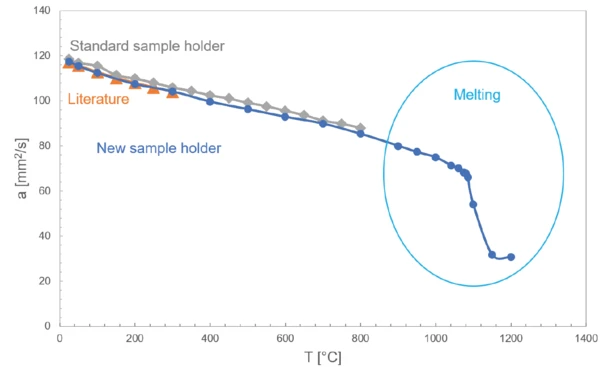Introduction
Determination of the thermal diffusivity, α, by means of LFA requires knowledge of the sample thickness, d, since the thermal diffusivity is proportional to the square thickness. For measurement of molten metals by LFA, it must therefore be ensured that the sample thickness does not change during the measurement.
The sample holder for molten metals made of SiC (up to max. 1250°C) can be used for such measurement [1]. It consists of a sapphire crucible, into which the metal is placed and sealed with a sapphire lid [1]. Some molten metals have high surface or interfacial tension, γ, as exemplified by the high value of γCu (T=1058 °C)=1304 mN/m in copper [2]. This high surface tension causes metals to form droplets during melting (figure 1). This may expand the sample thickness (from d0 to d1), resulting in a larger contact angle. Due to this, the metal may possibly no longer cover the entire bottom of the sapphire crucible, causing the light pulse to flash through the sample.

For measurement of metals with a very high surface tension, the new sample holder made of SiC is ideally suited (figure 2). In contrast with the conventional sample holder, this one has a thread screwing the SiC lid of the sample holder to the bottom, ensuring that the sapphire lid cannot move. It is thereby possible to prevent formation of droplets in the metal melt, thus achieving a defined thickness and entire wetting of the crucible bottom by the sample.

Material and Measurement Conditions
The material and measurement parameter employed are summarized in table 1.
Table 1: Material and measurement parameters
| Instrument | LFA 467 HT HyperFlash |
| Sample material | Copper, purity: 99.999% |
| Temperature range and sample holder |
|
Results and Discussion
The new sample holder was put to the test by measuring a copper sample. The copper sample in the new sample holder was measured from 25°C to 1200°C into the melt. Melting Temperatures and EnthalpiesThe enthalpy of fusion of a substance, also known as latent heat, is a measure of the energy input, typically heat, which is necessary to convert a substance from solid to liquid state. The melting point of a substance is the temperature at which it changes state from solid (crystalline) to liquid (isotropic melt).Melting of the sample can be recognized by the sharp decrease in thermal diffusivity (figure 3) and corresponds well with the literature value for the Melting Temperatures and EnthalpiesThe enthalpy of fusion of a substance, also known as latent heat, is a measure of the energy input, typically heat, which is necessary to convert a substance from solid to liquid state. The melting point of a substance is the temperature at which it changes state from solid (crystalline) to liquid (isotropic melt).melting point (peak temperature) of copper, at T=1083°C [3]. For comparison, the copper sample was measured with a standard sample holder of alumina (12.7 mm, round) in the temperature range from 25°C to 800°C below the melt (gray diamonds in figure 3). The deviation between the thermal diffusivity values measured with the standard sample holder, the literature values (orange triangles in figure 3), and the values measured with the new sample holder for molten metals is less than 3% for all temperatures measured.

Summary
A new sample holder made of SiC for the temperature range from room temperature to 1250°C has been developed; it is ideal for the measurement of molten metals. The screwable lid ensures that the sample thickness does not change even in the melt, which is essential for accurate determination of the thermal diffusivity. Measurements on copper show good agreement of the results with those measured using a standard sample holder and also with literature values.